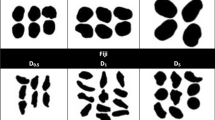Abstract
Study on shear strength and compressibility characteristics of soils considering anisotropy phenomenon is essential to the accurate design of structure foundations and stability analysis of earth structures. In this research, a series of triaxial and oedometer tests were used to study the mechanical behavior of a fine-grained cohesive soil considering the effect of inherent anisotropy on the behavior. For this purpose, a special soil sampler was made and different directions were selected to collect the samples from the site. All triaxial samples were isotropically consolidated under the effective stresses of 200, 300 and 500 kPa, and loaded at the rate of 0.05 mm/min. The results showed that the shear strength and compressibility of the soil intensively depend on the sampling direction. With an increase in the anisotropic angle, the shear strength values decreased and the settlement values increased. However, at the anisotropic angle of 72°, the shear strength and settlement have minimum and maximum values, respectively. In addition, a review of failure surface illustrates that as the angle between the failure surface and the bedding direction decreases, the failure surface tends to be closer to soil stratification and it causes an increment in pore water pressure and reduction in shear strength. In general, samples cored perpendicular to the bedding direction showed dilative behavior, whereas the other ones exhibited contractive behavior.














Similar content being viewed by others
References
Oda M (1972) The mechanism of fabric changes during compressional deformation of sand. Soils Found 14:1–18
Bjerrum L (1973) Problems of soil mechanics and construction on soft clays. Proc Eighth Int Conf Soil Mech Found Eng 3:111–159
Saada AS, Townsend FC (1981) “State of the Art: Laboratory strength testing of soils”. In: Young RN, Townsend FC (eds) Laboratory shear strength of soils. ASTM STP 740. American Society for Testing and Materials, pp 7–77
Jamiolkowski M, Ladd CC, Germaine TT, Lancellotta R (1985) New developments in field and laboratory testing of soils. A state of the art report. Proc Eleventh Int Conf Soil Mech Found Eng 1:54–153
Yamada Y, Ishihara K (1979) Anisotropic deformation characteristics of sand under three dimensional stress conditions. Soils Found 19(2):79–94
Tatsuoka F, Sonoda S, Hara K, Fukushima S, Pradhan TBS (1986) Failure and deformation of sand in torsional shear. Soils Found 26(4):79–97
Kamei T, Nakase A (1989) Undrained shear strength anisotropy of K0-overconsolidated cohesive soils. Soils Found 29(3):145–151
Kuganenthira N, Zhao D, Anandarajah A (1996) Measurement of fabric anisotropy in triaxial shearing. Geotechnique 46(4):657–670
Aghajani HF, Salehzadeh H, Shahnazari H (2015) Application of artificial neural network for calculating anisotropic friction angle of sands and effect on slope stability. J Cent South Univ 22(5):1878–1891
Yang LT, Li X, Yu HS, Wanatowski D (2016) A laboratory study of anisotropic geomaterials incorporating recent micromechanical understanding. Acta Geotech 11(5):1111–1129
Farhadi B, Lashkari A (2017) Influence of soil inherent anisotropy on behavior of crushed sand–steel interfaces. Soils Found 57(1):111–123
Al-Rkaby AHJ, Chegenizadeh A, Nikraz A (2017) Anisotropic strength of large scale geogrid-reinforced sand: experimental study. Soils Found 57(4):557–574
Lo KY (1965) Stability of slopes in anisotropic soils. Proc Inst Civ Eng Geotech Eng 91:85–106
Mitachi T, Kitago S (1976) Change in undrained shear strength characteristics of saturated remolded clay due to swelling. Soils Found 16(1):45–58
Clough GW, Hansen LA (1981) Clay anisotropy and braced wall behavior. J Geotech Geoenviron Eng 107(7):893–913
Su SF, Lia HJ, Lin YH (1998) Base stability of deep excavation in anisotropy. J Geotech Geoenviron Eng 124(9):809–819
Soroush A, Soltani-Jigheh H (2001) Effects of shear strength anisotropy on stability of earth structure. In: 54th Canadian geotechnical conference, pp 1110–1114
Islam MSha, Hoque, Eq (2003) Directional dependency of strength in compacted Dhala clay. J Civ Eng Inst Eng 31(1):25–35
Al-Rkaby AHJ, Chegenizadeh A, Nikraz HR (2017) Anisotropic shear strength of sand containing plastic fine materials. Int J Environ Chem Ecol Geol Geophys Eng 11(2):210–213
Attom MF, Al-Akhras N (2008) Investigation anisotropy in shear strength of clayey soils. Proc Inst Civ Eng Geotech Eng 161(5):269–273
Rowshanzamir MA, Askari AM (2010) An investigation on the strength anisotropy of compacted clays. Appl Clay Sci 50(4):520–524
Dawei Hu, Zhou H, Zhang F, Shao J, Zhang J (2013) Modeling of inherent anisotropic behavior of partially saturated clayey rocks. Comput Geotech 48:29–40
Tankiewicz M (2015) Experimental investigation of strength anisotropy of Varved clay. Proc Earth Planet Sci 15:732–737
ASTM D 2487 (2006) Standard practice for classification of soils for engineering purposes (Unified Soil Classification System), Annual Book of ASTM Standards, 04.08
ASTM D 4767 (2011) Standard test methods for consolidated undrained triaxial compression test for cohesive soils. Annual Book of ASTM Standards, 04.08
ASTM D2435/D2435M (2011) Standard test methods for one-dimensional consolidation properties of soils using incremental loading. Annual Book of ASTM Standards, 04.08
Author information
Authors and Affiliations
Corresponding author
Rights and permissions
About this article
Cite this article
Zarei, C., Soltani-Jigheh, H. & Badv, K. Effect of Inherent Anisotropy on the Behavior of Fine-Grained Cohesive Soils. Int J Civ Eng 17, 687–697 (2019). https://doi.org/10.1007/s40999-018-0292-1
Received:
Revised:
Accepted:
Published:
Issue Date:
DOI: https://doi.org/10.1007/s40999-018-0292-1




